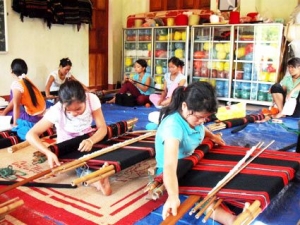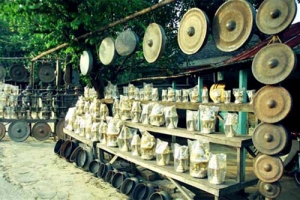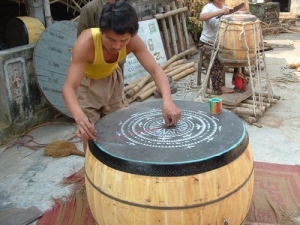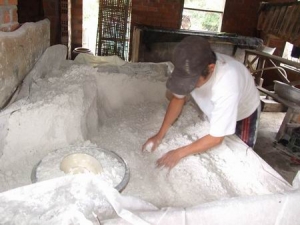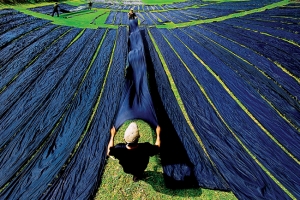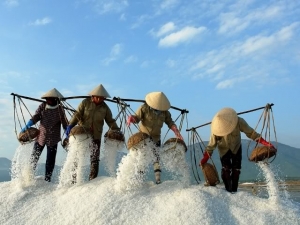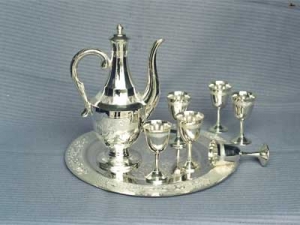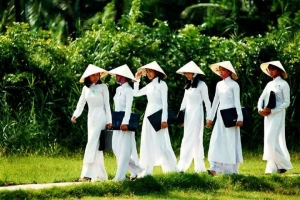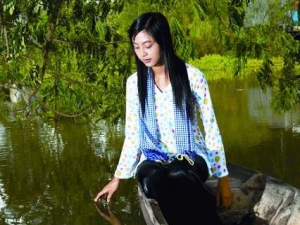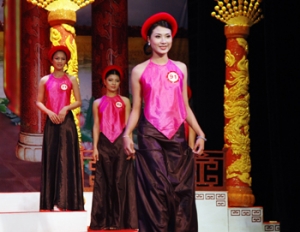
Asia Pacific Travel Team
Brocade Weaving - Occupation Of Cotu people
Although it has not developed as many different craff villages yet but brocade weaving occupation had become the traditional village baring the deep cultural characteristics of Cotu ethnic.
Brocade Weaving has a long life in Vietnam, is a cutltural characteristics of ethnic minorities as E De, M'Nong, Gia Rai, H'mong... The most excellent products belongs to Cotu ethnic.
With the skillful hand of Cotu women, they had changed the homemade materials into the products such as blankets, loincloths, skirts, etc with multiform color and unique vignettes.
The stage of weaving is made entirely by hand-made method, from growing material (cotton, jute, flax, etc) to finishing the products. As for brocade weaving, the Cotu women have to work hard during many days or a month to accomplish product entirely.
Brocade weaving occupation still retains the traditional characteristics of Cotu ethnic minority in village but gathers mainly in Tabhing (far 15 kms from Thanh My - Nam Giang district to the North-West of Quang Nam province). Herein, tourists will be exciting when being taught heartily by Cotu women to weave brocade products with simple looms that it was made from bamboo and wood.
Phuoc Kieu bronze casting craft village in Quang Nam
With more than 400 year-old history, Phuoc Kieu Bronze casting village (Dien Phuong commune, Dien Ban district) is one of the oldest village of Quang Nam province.
Phuoc Kieu is located on the national highway 1A, about 25km to the north of Da Nang, 40km to the south of Tam Ky city. Remarkably, the village lies between two world cultural heritage namely Hoi An ancient Town and My Son Sanctuary. Thereby, Phuoc Kieu will have lots of advantages in tourist attraction.
Some of the products made by this village are bells, gongs, gong-like music instruments, incense burners, lamp holders, ancient vases, and other bronze musical instruments which are normally used in festivals, ceremonies and daily life.

For a long time, the local people in Quang Nam Province have had a saying “Lam Yen drums and Phuoc Kieu gongs” to praise the traditional craft of casting gongs and bronze products of Phuoc Kieu Village. Artisans in the village are famous nationwide for the technique of casting gongs.
According to the village elders, for over 200 years the gongs cast by the villagers have been used by ethnic groups in mountainous areas in Truong Son Mountain Range and Tay Nguyen (the Central Highlands) and even by neighboring countries, such as Laos and Cambodia. Today, the ethnic groups in Tay Nguyen still go to the village to order the best sets of gongs despite the difficulties in getting there.Recently, artisans in the village successfully cast two bronze cannons similar to the ones used during the Nguyen Dynasty. Each cannon is 100kg in weight, 1.2 m in length and 25cm in diameter.
Recently, artisan Duong Ngoc Sang who has engaged in the craft for over 70 years, has been given the title “The Folk Artisan” by the State. He is considered a “living treasure” of the village because of his expertise in adjusting the sound of gongs.At present, the villagers in Phuoc Kieu not only make traditional bronze products, such as gongs, bells, urns, etc., but also many artworks for interior decoration and tourism.
Doi Tam drums - the culture of craft village
Coming to Doi Tam, visitors will see big drums placed in front of each house in the village and hear the sound of planers and saws from every house.
Drum viet nam, Doi Tam village is very famous for its drum-making techniques. The village is located at the foot of Doi Mountain in Doi Son commune, Duy Tien district, the northern province of Ha Nam. Doi Tam has 545 families and around 550 villagers are drum makers.
This craft village is located at the foot of Doi Mountain in Doi Son Commune, Duy Tien District. Drum making in Doi Tam is said to have a 1,000 year old history.
Legend has it that the founder of this craft was Mr. Nguyen Duc Nang. In the 10th century, he, together with his brother, chose this place to settle and handed down the drum-making craft to their villages. After Nguyen Duc Nang died, the villagers buried him at the foot of the mountain and honored him “Trang Sam” (Master of Thunder) in his memory. On the occasions of the Vietnamese Lunar New Year, and traditional festivals. Doi Tam residents com to visit the founder’s grave and burn incense to pay homage to him.
Drums of Doi Tam Village have been well-known throughout the country. These drums look simple but produce very beautiful sounds that seem to express of the makers. Visiting the village, you will have opportunities to study the secret of this craft.
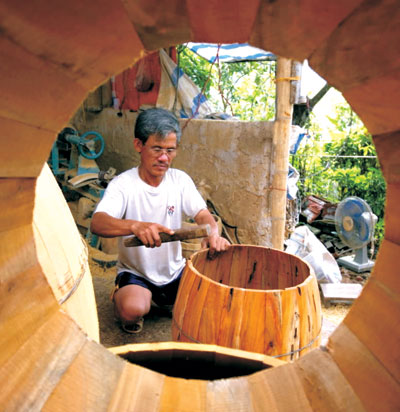
According to custom, drum-making techniques are transferred to sons and their wives, not daughters and their husbands. Any family that breaches the rules is expelled and cursed and booted from the drum-making occupation.
A drum is made in three major stages: leather tanning, drum-barrel making and drumhead stretching. Doi Tam craftsmen use buffalo skin to make drum heads.
They shave buffalo leather till it becomes very thin and dry it in the sun. The drum-barrel is made of dried jackfruit timber. Stretching a drumhead is the most difficult task because it requires craftsmen’s skills to assess the sound.
Doi Tam kids are taught about the village’s tradition when they are 5 years old. At the age of 14-15, Doi Tam boys travel with their fathers to other regions in the country to make and repair drums.
Not only does it make drums, the village has formed a drum-playing team with 60 members to serve festivals in the country.
Song Than Vermicelli Making Village in An Thai
Besides martial tradition, An Thai (Nhon Phuc - An Nhon) is also famous of a special noodle that is song than (song thằn) vermicelli. People call this noodle “song than” because they always make two noodle threads at the same time. Many people differently call it “song thần”.
Song than vermicelli (made into separate 30cm-wide square pieces, dried) has its fame thanks to especially delicious taste and high nutrition value. According to Mrs. Ly Thi Huong who is over 70 years old, the only person has kept the secret and produced song than vermicelli. Legend has it that the Nguyen Kings invited An Thai vermicelli makers to come to Hue kingdom to make song than vermicelli but they didn’t succeed because the water of Huong River was different from the Con River’s one (?).

Others say that song than vermicelli making comes from Chinese people living in An Thai in 18thcentury, but according to Mrs. Huong, it is totally Vietnamese and there is few persons know the secret of the career.

Song than vermicelli is made of green beans. In average, 5 kg bean, after grinded, washed, deposited filtered several times, generates 1.2 kg powder to produce 1kg vermicelli, so the cost is very high, making it not popular. Nowadays, song than vermicelli making career in An Thai has been remained but the product quality is not the same as before. People in the craft village have tried to improve the product quality, to make eye-catching covering package and to market the product.

Song than becomes a specious specialty, a kind of rare present. It’s so regrettable that the song than making career has been close to disappearance. Worry about this threat, Mrs. Ly Thi Huong has passed the career secret to her son. If there was a store selling Song than vermicelli in right An Thai (or Quy Nhon), guests could have a chance to enjoy a bowl of vermicelli cooked with chicken entrails and buy some kilograms for offerings, producing hometown’s specialty.
Tan Chau Silk Making Village
Tan Chau silk has its fame because of the softness, toughness, long-wearing and high absorbability of natural silk material. All clothes made from Tan Chau silk bring to people comfort, coolness in summer, warmness in winter. Tan Chau silk is deserved to be called “Queen” of silk.
Not only for legends and remains, Tan Chau silk village in An Giang is also famous for the brilliant past of a special craft village.
Tan Chau silk has its fame because of the softness, toughness, long-wearing and high absorbability of natural silk material. All clothes made from Tan Chau silk bring to people comfort, coolness in summer, warmness in winter. Tan Chau silk is deserved to be called “Queen” of silk.
Actually, materials for making Tan Chau silk are all produced by local people themselves. They grow shrubbery feeding silkworm to generate silk, plant mac nua (D. mollis) tree to take its fruit making dye. To make a unit of Tan Chau silk, the makers must spend many time and labor in many different parts of process. Firstly in silk choosing part, the maker must select the good type of silk to squeeze, seize on the loom then put on the weaving pattern. After finishing weaving, weaver starts the part of making dye. The big and young mac nua fruits are selected (the ripe ones are not suitable because of not having resin), kneaded well in mortar or in crushing machine and then dissolved in water, creating a nice yellow liquid which will turn into black when meeting the air and temperature. This liquid is filtered to leave the residue and used for dying.

Mac nua (D. mollis) fruit to make the dye
The part of dying silk is considered the most important and most elaborate one in the whole process which includes a hundred times of soaking silk in dye to ensure that each silk thread absorbs equally After each soaking time, people have to use their hands carefully squeezing silk then hang it out. When drying, they must choose the suitable sunny days in order to dry silk 4 units of sunlight per day. If being hang out in rain or light sunshine, the quality of silk will decrease. After about 40-45 days of dying and drying, the product is taken in new process becoming beautiful clothes which make people to contemplate and to praise because of their brilliant beauty.
Because of the long time and much labor for making Tan Chau silk, its price is very high. In about 60s -70s of 20th century, this kind of product was not suitable for daily needs of people then slowly came to disappearance. The internal market refused it due to its expensiveness while color was the reason for the refusal of external market.

Makers have found other dying technique to generate different colors
However, for recent years, due to the common direction of development and fashion trend leading to high quality products which express cultural features, the brand of Tan Chau silk begins to be restored and returned into deserved position. Besides the traditional black color of natural dye from mac nua fruit, Tan Chau silk makers have found other dying technique to generate different colors, meeting the customer’s requirements which are more various day by day. This is a valuable chance for a famous craft village, which has been down for a long time, to restore its thriving past.
Tuyet Diem Salt Making Village
The more blazing the sunshine is, the purer the salt is and… the saltier the sweat dropping on the makers’ bony shoulders is. Phu Yen has three craft villages that have made salt for more than 300 years: Trung Trinh, Le Uyen, Tuyet Diem (Song Cau district).
Previously, Tuyet Diem salt was called Cu Mong salt by the salt sellers. They called it this name because formerly, all boats and ships from different places in the country came there to buy salt following the direction of Cu Mong Pass’s foot, although Tuyet Diem is the only salt field of Phu Yen province. The white drops of salt have made up the beautiful name for the village.
Has been established since 1870, Tuyet Diem salt field, Xuan Binh commune, Song Cau, Phu Yen is 138 years old now.
Salt making career is much harder than farming. Every year, craftsmen work depending on only some sunny months of summer. The more blazing the sunshine is, the purer the salt is and… the saltier the sweat dropping on the makers’ bony shoulders is.
Song Cau salt has appeared in the poem of Che Lan Vien “Thousands of field squares of white salt”. For centuries, three salt making villages of Phu Yen has been famous all over Dang Trong region (the South). From small groups of salt makers (nau nai) that appeared since Phu Yen’s reclamation, Phu Yen salt has been well-known in the history and created a never-lasting destination: Nai Pass (the pass where salt is transferred). Nai Pass and Van Luong Pass (Xuan Thinh – Song Cau) are two famous destinations where there happened the dead battle of two army forces Tay Son and Nguyen Anh in the end of XVIII century .
Phu Yen salt making career has encountered many ups and downs. Despites of extremely hard working, the face toward the salty water, the back toward the sky, craftsmen still have tough life generation by generation.
Dong Xam Silver Engraving Village
Dong Xam silver engraving village belongs to Hong Thai commune, Kien Xuong district, Thai Binh province. It is famous for sophisticated and high-artistic-valued product.

Dong Xam village situates in the east of Kien Xuong district, belongs to Hong Thai commune. The silver engraving career in Dong Xam appeared in XVII century that means it has existed for about 400 years. Formerly, it was a career containing welding, bending basin, making knife and scissor, fixing lock, making handle and spout of pot, hubble-bubble … after that, the craftsmen turned to making jewelry, being specialized in silver engraving.

Like other senior craft careers such as bronze casting, metallurgy, jewelry making career brings high income for the craftsmen, the technique is strongly complicated so Dong Xam people have always kept the career secret for hundreds of years. Until now, although the technique is not monopoly of Dong Xam makers anymore, some of the most complex technical and artistic operations are still kept secretly. The old community of silver engraving craftsmen created strict rules noted in the conventions of the village which stated that: anyone who told the career secret to people from other places, other villages; or made the fake products to cheat people, creating impiety will be strongly punished or beaten before the Ancestor’s altar, or deleted from the list of community.

Silver stores of Dong Xam are totally different from and more special than ones in other places due to strange types of shape and appearance of the product; sophisticated and balance decoration projects which are brilliant and clearly express the main topic; light-dark operating method based on the reflective feature of silver. The typical features of Dong Xam silver products are the subtle virtuosity and maximum perfectness. It can be said that Dong Xuan silver artisans with their talent and carefulness have satisfied all requirements of the customers who are the most fastidious and most knowledgeable in art.
Nowadays, most of Dong Xuan craftsmen work in the village, many become rich. Some of craftsmen, especially young ones go to many other places, producing as well as training. In every environment, since previous time until now, Dong Xam silver makers have always put the credibility, talent on the first priority. They have kept ethic, conscience of the craftsmen and technical elite of the country’s traditional career.
Traditional Ao Dai for Tet
Most Vietnamese people wear new clothes to celebrate Tet, or the Lunar new year, in order to promote a fresh beginning to the year. Although Western-style outfits are more convenient for daily chores, the traditional tunic, or ao dai, reappears each Tet. These tunics add to the festival’s formal atmosphere.
Most Vietnamese people wear new clothes to celebrate Tet, or the Lunar new year, in order to promote a fresh beginning to the year. Although Western-style outfits are more convenient for daily chores, the traditional tunic, or ao dai, reappears each Tet. These tunics add to the festival’s formal atmosphere.
In the past, all ao dai were lined. The two layers of fabric formed a set, or kép(in Vietnamese). On formal occasions, another light ao dai, always white, was worn as an undergarment under the kép to form a triple set of layers called mớ ba. This was the proper way to wearao dai until only a few decades ago. To deal with sudden encounters, such as the frequent visitors who often drop in without notice around Tet, a “hasty”ao dai could be thrown over whatever the host was wearing. From the mid-1950s, the ao dai was simplified and the kép layer eliminated.
For centuries, male and female ao dai were cut similarly, except that the neck of the women’s ao dai was about two cm high, while the male collar measured 3.5cm. The wide, down-curved hem, about 80cm across, hung about 10cm below the knee. Royal’s ao dai were of standard cut but were fashioned in different colors and materials.
Long ago city ladies had their ao dai made from colorful silk brocades and lampas. French influence popularized velvets in shades of burgundy, dark green and dark blue. While town women wore five-paneledao dai, or nam ta, women in the countryside had front-opening four-panel ao dai called tu than. The rural tu than were made from hemp-based fabrics, normally in a brown or brownish-fuchsia color.
The tu than tunics worn by wealthy countryside people at Tet were beautiful,with eight flowing silk strips in front. The inner-most layer featured two strips in the color of a lotus flower, about two meters long and 25cm wide, which wrappered around the waist and the knotted to make a bow in front. Next came the two long ends of a light yellow crepe money belt, and finally a bow and strips formed by a soft green silk belt. The two dark brown front flaps of thetunic were lightly tied under those strips to enhance their vivid colors.
Well-dressed Men
As for men’s ao dai, father Cristoforo Borri, an Italian Catholic priest who traveled through the northern Principality (today’s northern Vietnam) in the 17th century, wrote in his 1631 book “Relations de la Nouvelle Mission des Peres de la Compagnie de Jesus au Royaume de la Cochinchine” that most northern men wore a blackao dai over other layers on most festive occasions. This remained unchanged in Vietnam until recently.
Traditional ao dai pants were moderately wide with a low crotch. Conventionally, married women wore black satin pants with their ao dai. Young maidens and men wore white ao dai pants. In Hue people of all ages and sexes wore only white pants. Hue’s upper-classes of both sexes added tree pleats to their pant’s outer edges so that the pants flared out when they moved. These pleated pants are called chít-ba.
Following the mishaps of history that have marred so many traditions, Vietnam is bouncing back in peace time. With Vietnamese people’s innate pride in their culture, it will not be long until visitors can witness a traditional Vietnamese Tet, complete with authentic and colorful ao dai.
Impressive Costumes of Vietnamese Southern Women
The costume of women in South Vietnam has gone through many stages of development, but still preserves its distinctive and unique imprints of the traditional culture.

Costumes of southern women and children in the old days

Attires of southern women in the old days
Initially, the women’s costume in the North of Vietnam was ao tu than (four-piece blouse) with a bodice, a skirt and a headscarf of the ancient Vietnamese women. When the country was separated into Dang Trong (the South) and Dang Ngoai (the North), the Lords of Dang Trong instituted a cultural reform, including a costume reform to differentiate local people’s costumes from those in Dang Ngoai.

Wedding dresses in the old days
In the 18th century, the southern women wore long five-flap shirts with black loose trousers, with their hair in a high bun and they walked barefooted both at work and in the town. And this five-piece shirt was considered as the forerunner to the current ao dai of southern women, which was preserved due to the development of the sericulture and fabric weaving. As there was a class division in the feudal society, common women wore long black shirts made from coarse materials, whereas upper class women wore shirts made from smooth and cloths with "main colors" such as yellow, blue, red and purple. They usually wore long shirts in blue or violet, their hair in a bun, curved shoes and flat balm hat with fringes. Besides, dark hues were considered more suitable for women living in wet areas.
At that time, the wedding gown comprised a halter-neck and a long-sleeved shirt, which were redesigned from ao mo ba mo bay (shirt of several flaps), to be suitable to the sultry weather.

Wedding costumes in the 1940s
In the 19th century and early 20th century, due to the influence of the French culture, the ao dai was harmoniously designed between the traditional culture and the western style. It was made tighter, clinging to the body and more colorful, from thin materials and worn with loose white trousers. In the 1970s, the south was the vanguard in renovating the costume. Southern designers made it cling to the body with narrowed flaps, especially they made use of the Raglan shoulder to avoid creases and give the dress a softer, more flowing appearance.
Then, the ao dai became the traditional dress of the Vietnamese women. It helps wearers look charming and attractive, elegant and romantic. Moreover, it also graces the lissomness and gentleness of the women.

Wedding costumes in the 1940s
Nowadays, the Ao Dai is still the much-feted costume of Vietnamese women at wedding parties, festivals and offices. Hence, many famous fashion designers such as Minh Hanh, Si Hoang and Lien Huong design the Ao Dai in different styles with unique patterns, which harmoniously combine the beauty of traditional style and the modernity of the West.
Besides the traditional dress, the ao ba ba (loose-fitting blouse), which entered Vietnam from Chinese traders and was redesigned several times, has become the distinctive costume ofsouthern women . Initially, the ao ba ba was black and tailored with pockets and splitting flaps at the hip. It was worn along with a bandana, suitable to the life of women in watery areas. Later, designers made it tighter with the Raglan shoulder, and in light and bright hues that make the ao ba ba more feminine and beautiful.
Ao Yem Vietnam and its history
Images of graceful girls in national charming long dress have been a symbol of Vietnam. However, looking back the historic development of national dress, Vietnam not only has Ao Dai but also Ao Yem – the indispensable dress of ancient girls.
In the old days, ao yem was called yem. It is an age-old dress which is maintained until today. Ao yem was used by all levels of society from working class to upper class. It also was used widely in traditional festivals therefore it was the national traditional clothes of ancient ladies.
Ao yem appeared in Vietnamese life in a very old day but until Ly dynasty it was basically in shaped. Through the stream of history, ao yem was changing incessantly and improving its design. However the revolutions of ao yem only happended at the beginning of the last century while western trouser and skirt were entering Vietnam. In 17 century, ao yem did not have any big change of model. In 19 century, ao yem has a square piece is cloth with one corner cut away to fit under the woman’s throat. This scrap of fabric is secured across the chest and stomach with thin strings. There were three common models of ao yem: ao yem co xay, ao yem co xe, ao yem co canh nhan.
Entering 20 century, ao yem was used widespread with many of rich designs and models. Ao yem which has brown color and was weaved by rude cloth was for labor. Urban women favored white, pink or red ones, while women in the countryside wore ao yem in brown or beige, colors suited to their rustic environment. On special occasions, like the Lunar New Year or festivals, rural women would also wear brightly colored ao yem.
There is one kind of ao yem which was often wore by ancient ladies was called “yem deo bua”. The name was “yem deo bua” because it has a small pocket of musk beside and it was an advantage weapon of ancient ladies…furthermore, ao yem made many original love stories.In the old day when a girl had a date with her darling, she usually put a piece of betel inside her ao yem; it was called “khau trau dai yem” and maybe there is no kind of betel more supernatural than this kind of betel.
Today, the ao yem is appreciated for its cultural and artistic values. And on festive occasions, women throughout Vietnam are embracing the ao yem and other traditional clothes with renewed enthusiasm.


